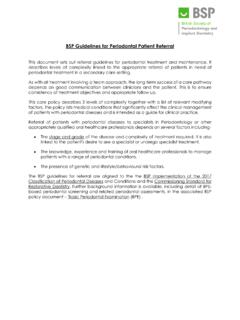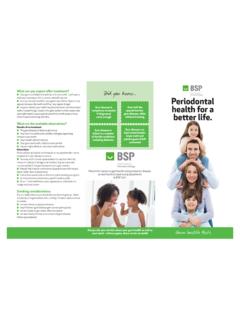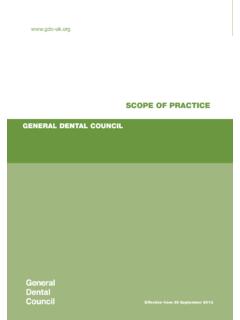Transcription of Basic Periodontal Examination (BPE)
1 Scoring CodesPockets < calculus/overhangs, no bleeding on probing (black band entirely visible)Pockets < calculus/overhangs, bleeding on probing(black band entirely visible)Pockets < or subgingival calculus/overhangs(black band entirely visible)Probing (Black band partiallyvisible, indicating pocket of 4-5mm)Probing depth > (Black band disappears, indicating a pocket of6mm or more)Furcation involvement02413* Basic Periodontal Examination (BPE)Careful assessment of the Periodontal tissues is an essential component of patient management. The BPEis a simple and rapid screening tool that is used to indicate the level of further Examination needed and provide Basic guidance on treatment needed.
2 These BPEguidelines are not prescriptive but represent a minimum standard of care for initial Periodontal assessment. BPEshould be used for screening only and should not be usedfor clinician should use their skill, knowledge and judgment when interpreting BPEscores, taking into account factors that may be unique to each patient. Deviation from these guidelines may be appropriate in individual cases, for example where there is a lack of patient engagement. General guidance on the implications of BPEscores is indicated inthe table below. The BPEscores should be considered together with other factors when making decisions about referral (as outlined in the companion BSP document Referral Policy and Parameters of Care ).
3 Guidelines for the use of BPEin younger patients can be found in the BSP document Guidelines for Periodontal screening and management of children and adolescents under 18 years of age. How to record the dentition is divided into 6 sextants and the highest score for each sextant is recorded:Upper right (17 to 14)Lower right (47 to 44)Upper anterior (13 to 23)Lower anterior (43 to 33) Upper left (24 to 27)Lower left (34 to 37) teeth in each sextant are examined(with the exception of 3rd molars unless 1st and/or 2nd molars are missing). a sextant to qualify for recording, it must contain at least 2 World Health Organisation (WHO) BPEprobe is used.
4 This has a ball end in diameter and a black band from to Light probing force should be used (20-25 grams). probe should be walked around the teeth in each sextant. All sites should be examined to ensure that the highest score in the sextant is recorded before moving on to the next sextant. If a code 4 is identified in a sextant, continue to examine all sites in the sextant. This will help to gain a fuller understanding of the Periodontal condition and will make sure that furcation involvements arenot UK Implementation guidance of the 2017 Classification for Periodontal and peri-implant diseases and conditions maps to the BPE guidelines and is documented in Periodontal diagnosis in the context of the 2017 classification system of Periodontal diseases and conditions Implementation in Clinical Practice, T.
5 Dietrich, P. Ower, M. Tank, N. X. West, C. Walter, I. Needleman, F. J. Hughes, R. Wadia, M. R. Milward, P. J. Hodge, I. L. C. Chapple & on behalf of the British Society of Periodontology, BDJ volume 226, pages 16 22 (11 January 2019) byGuidance on Interpretation of BPE ScoresNo need for Periodontal treatmentOral hygiene instruction (OHI)As for Code 1, plus removal of plaque retentive factors, including all supra and subgingival calculusAs for Code 2 and RSD if requiredOHI, RSD. Assess the need for more complex treatment; referral to a specialist may be indicatedTreat according to BPE need for more complex treatment; referral to a specialist may be indicated02413*An example BPE score grid might look like this:Both the number and the * should be recorded if a furcation is detected.
6 The score for a sextant could be 3* (indicating a probing depth plus a furcation involvement in the sextant).433*-24*Date published: January date:January by: Council of the British Society of Periodontology. The BPE was first developed by the British Society of Periodontology in versions of this document were produced in 1986, 1994, 2000, 2011 and 2016. The British Society of Periodontology to Use BPE All new patients should have the BPE recorded For patients with codes 0, 1 or 2, the BPE should be recorded at every routine Examination For patients with BPE codes of 3 or 4, more detailed Periodontal charting is required Code 3: Initial therapy including self-care advice (oral hygiene instruction and risk factor control) then, post-initial therapy, record a 6-point pocket chart in that sextant only Code 4.
7 If there is a Code 4 in any sextant then record a 6-point pocket chart throughout the entire dentition BPEcannot be used to monitor the response to Periodontal therapy because it does not provide information about how sites within a sextant change after treatment. To assess the response to treatment, a 6-point pocket chart should be recorded pre and post- treatment For patients who have undergone initial therapy for periodontitis, and who are now in the maintenance phase of care, then full probing depths throughout the entire dentition should be recorded at least annuallyIn addition it is recommended that: BPE should not be used around implants (4 or 6-point pocket charting should be used) 4sextantstoallowassessmentofbone loss as apercentage of root length andvisualisationofthe periapicaltissues When a 6-point pocket chart is indicated it is only necessary to record sites of 4mm and above (although 6 sites per tooth should be measured) Bleeding on probing should always be recorded in conjunction with a 6-point pocket chart














